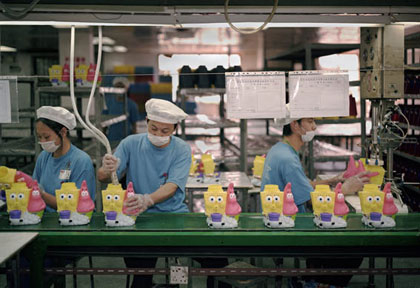The 111th Canton Fair (CECF) had come to a close yesterday. According to Liu Jianjun, the spokesman of the Fair, the number of European and American buyers began to stabilize. As for the buyers from Middle East and Russia, the numbers grow by double-digit. Reporter learned from the mechanical and electrical, lighting, auto and other industries, that although the number of the buyers attending this Fair had not experienced any major change, three problems, namely, the loss of European and American orders, the rising labor cost and the fluctuations in foreign exchanges, still exert great pressure on those exhibitors.
European and American Buyer’s Purchasing Intention Significantly Decreased
From recent days of visits, we get to know that apart from reduced orders, the trend of the increase in short-term orders and decrease in long-term ones in the second half of last year remains, and buyers from traditional market like Europe and America shows obvious unwillingness in purchasing, and although the orders from the emerging market are increasing, their reputation is to be improved.
According to Du Deli, general manager of Zhejiang cutting-edge Car Accessories Co., Ltd, “This year there are less customers, still less to say the orders, compared with the time before the 2008 economic crisis, the European and American order reduced by 3 folds. Although the order increase in the emerging market offset the decrease in the European market, some of the customers’ credit is not good, making the breach of contract a common place. If the customer refuses to take the goods, the company would suffer from a great loss even if the deposit had been in place.
The salesman for the European Market at SUMEC Electrical and Mechanical Co., Ltd said that the preliminary estimate showed that the overall procurement of the European merchants declined by 30%. “Before, the European customers would made orders of thousands of machines, but now the orders has shrank to only hundreds.
The latest data from the Guangdong Branch of the General Administration of Customs evidently manifested this phenomenon. In the first quarter of Guangdong’s export and import volume with The European Union , Japan and China Taiwan are $ 22,150,000,000 $ 16,960,000,000 and $ 11,340,000,000 respectively, down by 1.3% , 2.9% and 6.3% respectively ; the imports and exports with the ASEAN is $ 21.11 billion , an increase of 0.5%; and that with Korea, $ 11.4 billion, a growth of 35.3%. Among which the export with Korea had increased by 1.1 fold. And the export and import volume with the Africa amount to 8.96 billion USD, increased by 53.4%.
Product Price Rise Cannot Keep up with the Rising Labor Cost
Apart from the worries about the orders, the companies still worry about the rising cost of the upstream cost. According to Du Deli, besides the rising cost of the raw material, the labor cost is also a big worry. Compared with last year, the labor cost increased by 25% to 40%, while the product prices over the same period rose by only 5% -10%.
Zhang Xiangchen , director of the Policy Research Office of the Ministry of Commerce previously cited Standard Chartered Bank’s findings of 200 Hong Kong enterprises in the Pearl River Delta that this year, wages have risen by 10%.over the past four years, the average annual increase of labor cost was 20%.
AlixPartners Consulting Firm pointed out that if the Chinese currency and shipping costs gradually increased by 5%, while the wage level of annual growth is 30 %. In that case, by 2015, the production costs will be even with Mexico, and as a result, the price advantage of the labor cost will weaken.
Most SMEs Would Have Difficulties in Deal with the Exchange Rate Fluctuations
After The RMB exchange rate floating range enlarged by one fold, the risk rises in short-term transactions. As a result, how to deal with the exchange rate fluctuations becomes an important issue of this trade fair.
Huang Liang, operation director of the Madeinchina.com, a website focusing on matchmaking for the overseas buyers and Chinese export companies, said that in face of the rate fluctuation, the enterprises can resort to non-dollar settlement, or to shorten the borrowing time as short as possible.
However, while fixed exchange rate can be a way. If the customers asked for an extension, the fixed exchange rate will expire. And as the added values of the products from SMEs are relatively low, when faced with rate fluctuations, these enterprises can do nothing but negotiate for a price rise with the customers. and as is often the case, the customers would not be able to fend for themselves, still less to say paying more. the only way left for these SMEs to struggle. Therefore, to produce competitive products is a necessity for enterprises’ transformation. Liu Jianjun also suggests that the export enterprises should increase their competitiveness and strive for a strong pricing power.







[…] for the buyers from Middle East and Russia, the numbers … … Read the original here: The Canton Fair Experience Order Loss As Made in China Products … ← China's 2012-13 Corn Imports May Rise 50% – MarketWatch … Mining Machine […]